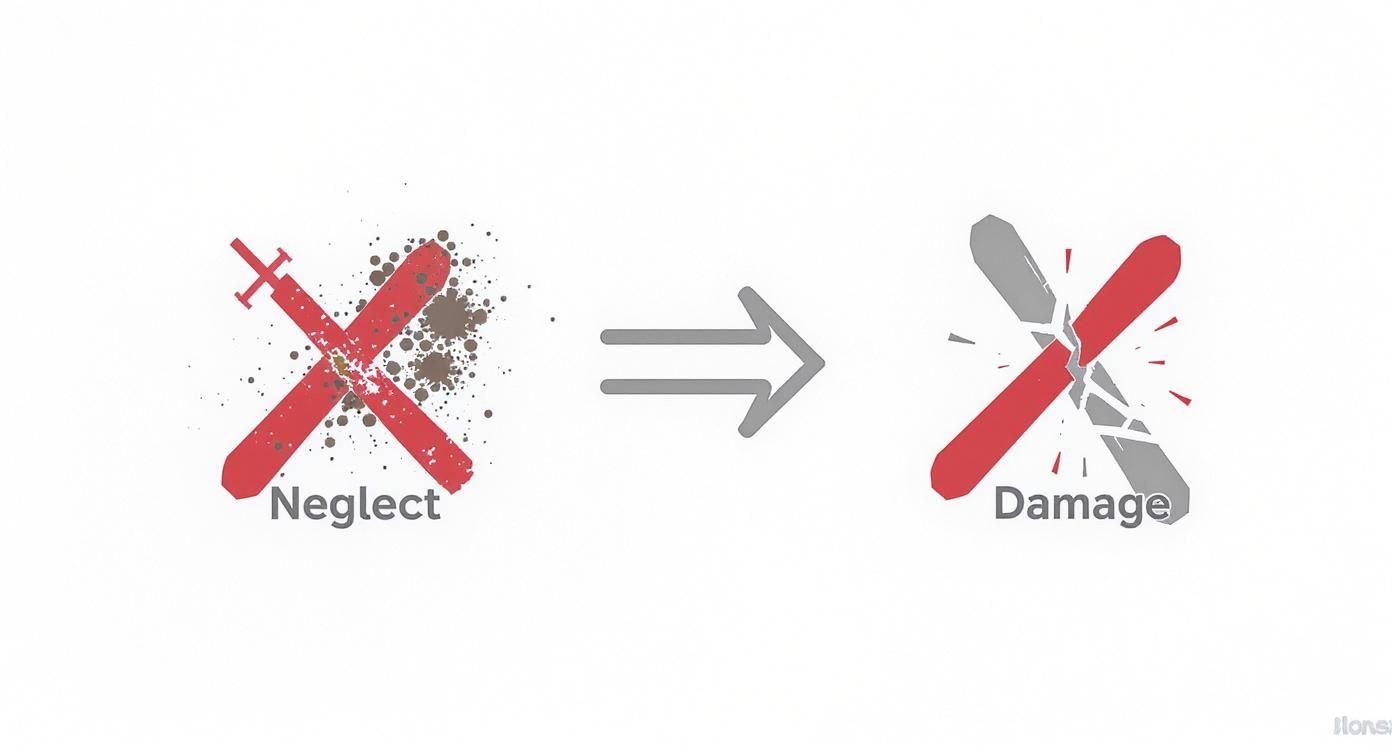The best way to store skis? It involves a thorough cleaning, a protective layer of storage wax, and finding a dry, climate-controlled spot. Just leaving them in a damp garage corner is a surefire way to invite rust, delamination, and a serious drop in performance, compromising your expensive gear over the off-season.
Why Proper Ski Storage Matters More Than You Think
It’s tempting, I get it. The season ends, and you just want to toss your skis in the garage and forget about them until the first snowfall. But that's a costly mistake. Your skis are a sophisticated mix of wood, metal, and composite materials that really don't play well with environmental stress.
The biggest culprits are the wild swings in temperature and humidity common in garages, attics, and sheds. This constant expansion and contraction can cause the layers of your skis to literally pull apart—a process called delamination. At the same time, moisture settles on the metal edges, leading to rust that completely kills their precision and grip on icy slopes. The base material, known as P-Tex, can also dry out and oxidize, leaving you with a slow, brittle surface that won't absorb wax properly.
The Real Cost of Neglect
Ignoring these factors doesn't just make your skis a little slower; it actively wrecks your investment. In fact, improper storage can lead to a 30% reduction in base durability and compromise edge integrity within a single off-season. This damage isn't always obvious to the naked eye, but you'll definitely feel it on your first run when your skis feel sluggish and totally unresponsive.
The bottom line is simple: proper storage isn't just about being tidy. It’s a critical part of ski maintenance that preserves the integrity, performance, and lifespan of your gear, making sure they’re ready to carve from day one.
Protecting your gear often comes down to finding the right environment. Learning about the benefits of climate-controlled storage shows how it extends beyond just skis, protecting any valuable items from temperature and humidity damage.
Before we dive into the steps, let’s quickly look at what not to do. I’ve seen these mistakes cost people a lot of money and frustration over the years.
Common Storage Mistakes vs Pro-Level Practices
Avoiding these common pitfalls is half the battle. Now, let’s get into the right way to put your skis to bed for the summer.
Your Essential Pre-Storage Cleaning Routine
Before you even think about stashing your skis for the summer, the single most important thing you can do is give them a thorough cleaning. All that grime, road salt, and dirt from those final slushy spring days isn't just an eyesore—it's actively working to destroy your gear.
Letting that gunk sit on your skis is a recipe for disaster. Over the off-season, the chemicals and salt will slowly eat away at the metal edges, leading to rust. At the same time, dirt grinds into the P-Tex base, making it harder for it to absorb wax when the snow flies again. A good clean now prevents some seriously ugly (and expensive) damage later.
This infographic lays it out perfectly, showing how skipping this step directly leads to long-term equipment damage.

It’s pretty clear: ignoring a pre-storage clean is a fast track to rusted edges and a compromised base, which happen to be the top reasons for costly repairs.
Getting the Grime Off
Grab a soft cloth and either a mild degreasing soap or a dedicated ski base cleaner. Gently scrub the entire base to lift away any old wax and lingering dirt. Don't forget about the top sheets and sidewalls; you'd be surprised how much filth they collect. For the bindings, a soft brush is perfect for clearing out any debris from the springs and mechanisms.
Once they're clean, you have to dry every single part of the ski. Be meticulous and pay extra attention to:
- The area around and under the binding brakes
- The full length of the metal edges
- Any nooks and crannies in the binding heel and toe pieces
Moisture is the absolute enemy here. Any dampness left behind is an open invitation for rust. In fact, data from European ski shops reveals that over 60% of off-season repairs are for totally preventable storage-related issues like rusted edges and dried-out bases.
Pro Tip: A can of compressed air is your best friend here. Use it to blast water out of those hard-to-reach spots in your bindings. This is the best way to ensure no hidden moisture is left behind to cause corrosion all summer.
Taking the time to prep your skis properly isn't all that different from packing other seasonal items with care. If you're decluttering your closet at the same time, you might find our guide on how to pack clothes for storage useful for protecting your other gear, too. This simple cleaning routine is the foundation for keeping your skis healthy for years to come.
Applying Storage Wax to Protect Your Bases
Once your skis are clean, it's time for what I consider the single most important step for off-season prep: a good coat of storage wax. So many people skip this, but it’s a total game-changer for preserving your ski bases.
Think of your ski base like skin—if you leave it exposed to dry air for six months, it's going to get dried out, oxidized, and brittle. That oxidation creates a slow, chalky surface that just won't absorb fresh wax properly when the snow starts falling again. A thick layer of storage wax acts as a shield, sealing the P-Tex material from the elements. It’s a simple move that keeps the base hydrated and ready to rip next season.

The good news is, this process is way easier than a standard hot wax because you're going for protection, not on-snow performance. You don’t need any fancy, temperature-specific race wax here. A basic, inexpensive all-temperature or universal wax is perfect for the job.
The Waxing Process Simplified
First things first, get your waxing iron set to a low temperature. You want it just warm enough to melt the wax without it smoking. If you see smoke, the iron is way too hot and you risk damaging your base.
Drip a generous amount of wax all over the base. Don't be shy with it—you want full coverage from tip to tail. Then, slowly run the iron over the base to spread the wax into a thick, even layer. Make sure you get the wax all the way over the metal edges, too. This helps protect them from rust over the humid summer months.
The most important part of this whole process is what you don't do next: Do not scrape the wax off! That thick, messy-looking layer is the armor that's going to protect your skis all summer.
When winter finally rolls back around, you’ll just need a plastic scraper to peel off that old storage wax before you apply a fresh coat for the snow. This technique is a cornerstone of smart gear care, and you can find more pro tips in our guide to long-term storage tips for all your equipment.
Easing Binding Tension for Long-Term Health
Your ski bindings are true marvels of engineering. But at their core, they use incredibly powerful springs to do two critical jobs: keep you locked in when you need to be and release you safely during a fall.
Leaving those springs fully cranked to your regular DIN setting all summer is like holding a muscle in a tensed position for months—it eventually leads to fatigue.
This constant pressure can cause the springs to slowly lose their calibrated tension. When that happens, your release values might become inconsistent, which is a huge safety issue on the slopes. A binding that pops off too early or, worse, fails to release when it should is a major liability.

How to Safely Adjust Your Bindings
Thankfully, giving your bindings a rest for the summer is a simple task. All you need is a screwdriver that fits the adjustment screws on both the toe and heel pieces of your bindings.
- Find the Toe Piece Screw: Locate the screw, usually right near the visible DIN window. Turn it counter-clockwise until the indicator points to the lowest number on the scale.
- Find the Heel Piece Screw: Now, do the exact same thing on the heel housing. Find the screw and turn it until the setting is at its minimum value.
This little bit of effort is a massive part of properly storing your skis for the off-season. In fact, some experts estimate that releasing the tension can extend a binding's functional life by approximately 20% compared to leaving them cranked all summer. You can read more about ski equipment trends and maintenance at verifiedmarketresearch.com.
Crucial Pro Tip: Before you touch a single screw, pull out your phone and take a clear, close-up photo of your DIN settings. Another easy trick is to jot the numbers down on a piece of masking tape and stick it right onto the ski. This way, you’re guaranteed to reset them correctly before that first glorious day back on snow.
Proper storage is the key to making all your expensive gear last. For more tips, check out our complete guide on how to store sports equipment.
Finding the Perfect Spot to Store Your Skis
Now that your skis are prepped and waxed for their long nap, the next big question is where to put them. Finding their summer home is a huge deal—where your skis live during the off-season has a massive impact on their lifespan.
And trust me, not all spots are created equal. The goal is to find a place that shields them from their two biggest enemies: wild temperature swings and humidity.
This is exactly why garages, attics, and outdoor sheds are notoriously bad choices. These spots can feel like an oven in the summer and get damp on rainy days, forcing the materials in your skis to expand and contract over and over. That constant stress is what leads to delamination, rusty edges, and a brittle base that just won't hold wax. The best way to store skis is simple: find a stable, climate-controlled environment.
Ideal Indoor Storage Solutions
Think about the places inside your house that stay at a pretty consistent temperature all year. A bedroom closet, a spare room, or even tucked away under your bed are all fantastic options. These spots don't have the crazy environmental shifts that can slowly ruin your gear.
If you want to dive deeper into why this stability is so important, check out our guide on the importance of climate-control storage for all your valuable stuff.
Once you’ve scouted out a good location, think about how you’ll actually store them:
- Padded Ski Bag: A breathable, padded ski bag is your best friend if you're short on space. It keeps your skis safe from dust and accidental dings while still letting any leftover moisture escape.
- Ski Straps: At the very least, grab a pair of ski straps to hold your skis together, base-to-base. This protects that fresh layer of storage wax and keeps the bases from getting scraped up.
- Wall-Mounted Racks: If you’ve got the wall space, a dedicated rack is the superior choice. It gets your skis up off the floor and prevents any awkward pressure points that could lead to warping over time.
Pro ski shops and high-end resorts have known this for decades. They use padded, climate-controlled racks to preserve their fleets, a practice shown to cut down on equipment repair frequency by up to 45%.
Even if you're thinking about a garage rack, remember that climate is still the most important factor. While some articles on utilizing bike hooks for efficient garage storage have great ideas for hanging gear, it doesn't solve the temperature problem. If your garage isn't insulated and climate-controlled, that indoor closet is still the much safer bet.
Answering Your Top Ski Storage Questions
Even after you've done all the prep work, a few questions always seem to linger. Let's clear up some of the most common ones so you can feel completely confident about your off-season ski care.
People often ask if it's okay to store skis standing up. The short answer is a definite yes. Storing them vertically is perfectly fine, just make sure they're in a stable spot where they won’t get knocked over. Honestly, the orientation matters way less than the climate they're stored in and the prep you did beforehand.
What About Edges and Rooftop Boxes?
Another big question is about sharpening edges before putting skis away. My advice? Wait until the next season starts. Freshly sharpened edges are much more likely to rust if even a tiny bit of moisture gets trapped during storage. Clean them up, coat them in that storage wax we talked about, and then get your tune-up done right before you hit the snow for the first time.
And that rooftop ski box on your car? It might seem like an easy storage spot, but it's one of the absolute worst places for your gear.
A rooftop box is a death sentence for skis. It basically becomes an oven, trapping intense heat and humidity that can delaminate your bases, rust your edges, and wreck the core materials in just one summer.
Don't forget, poor storage can have real-world consequences. Big brands like Salomon and Atomic often have warranties that won't cover damage from neglect, which really drives home how important proper care is. If you're curious, you can find more details on ski market trends and equipment care at verifiedmarketresearch.com. Taking these simple steps protects your investment and ensures your skis are ready to rip when winter returns.
For a hassle-free solution that guarantees a climate-controlled environment, let Endless Storage handle it for you. We pick up, store your gear safely, and return it on demand. Learn more about our effortless box-based storage today!
Frequently Asked Questions
Unveiling the Secrets to Effortless Storage
Endless Storage is available nationwide. You pick a plan, tell us where to pickup, and we'll send a UPS van to collect, whichever state you're in.
Your shipping label will be sent to your email within a few minutes, if not instantaneously. It can also be accessed through your customer profile.
Your box will be shipped to one of our climate controlled self storage facilities in our closest self storage facility. Our manager will accept your package, notify you that your box has been received, and securely stored. Only our managers will have access to Endless Storage boxes.
Email us at admin@endless-storage.com click to live chat with us, or send us a message below.
Never! We're committed to transparent pricing with no surprises. You'll lock in your rate with no hidden fees and no long-term contracts.
Fast access guaranteed! Your boxes will arrive at your doorstep within 48 hours of requesting them back. Need to check on delivery? We provide tracking information for complete peace of mind.
Totally flexible! Store month-to-month with no long-term commitment and cancel anytime.
Everything's online! Use your account dashboard to:
• Set up automatic monthly payments
• Request box returns
• Update your address
• Order additional boxes
• Track shipments
Your boxes are insured up to $100 each. Our customer service team will help you file any necessary claims and resolve issues quickly.
Don't worry – we'll email you right away if there's a payment issue. Your items stay safe, though you may have temporary service interruption or late fees until payment is resolved.
When you request our free storage kits, you'll have 30 days to send in your boxes to activate your 3 months of free storage. Think of it like starting a gym membership – your activation window begins when you receive your kits, and your full free trial begins once you send in your first box. During your free months, you'll experience our complete storage service at no cost.
Your 30-day activation window begins when you receive your storage kits. We'll send you an email confirmation when your kits are delivered, marking the start of your activation period.
If you haven't sent any boxes for storage within your 30-day activation window, your free trial will expire and we'll begin charging the regular monthly rate of $9.99 per box. This helps ensure our storage kits go to customers who are ready to use our service.
A box costs $9.99 per month to store (plus sales tax). This price includes free shipping for standard boxes under 50 lbs. and smaller than 16"x16"x16"
Log into your Endless Storage account, locate the box you would like returned, and simply click Return My Box.
Yes, each box stored with us is insured for up to $100 throughout transit as well as the duration of storage within our facilities.
Your box will be at your doorstep within 48 hours of you requesting it back.
Store 10+ boxes? We'll pick them up for free! After your purchase, we'll contact you to schedule a convenient pickup time and arrange UPS collection.
We trust UPS with all shipments, and every box includes $100 insurance coverage. You'll receive tracking information to monitor your items' journey.
Yes! Visit any of our locations by appointment. Just bring a photo ID matching your customer profile.
For everyone's safety, we can't store hazardous materials, firearms, or perishables. All items must fit within our standard boxes.
It's easy! Order your storage kit online, and we'll ship it to you within 1-2 business days. Your shipping labels will be emailed instantly and available in your account.
We're here to help! Email us at admin@endless-storage.com, use our live chat, or send us a message through your account.
To cancel your storage service with Endless Storage, please email your cancellation request to admin@endless-storage.com. Our team will process your request within 2 business days and confirm your cancellation via email.
We understand packing takes time. However, to maintain your free trial benefits, you'll need to send at least one box within the 30-day activation window. If you need more time, you can always start with one box to activate your trial and send the rest later. You can always reach out to admin@endless-storage.com if you have any issues or concerns.
When you request our free storage kits, you're starting a 30-day window to begin using our storage service.
To avoid any charges, simply send at least one box for storage within 30 days to activate your 3-month free trial. If you decide not to use our service and don't send any boxes within the 30-day window, a one-time $50 fee will apply to cover the costs of materials and shipping. This helps ensure our storage kits go to customers who are ready to use our service.
Think of it like reserving a hotel room – we're setting aside space and sending specialized packing materials for your use. The fee only applies if you request materials but don't begin storage, similar to a hotel's no-show charge.

